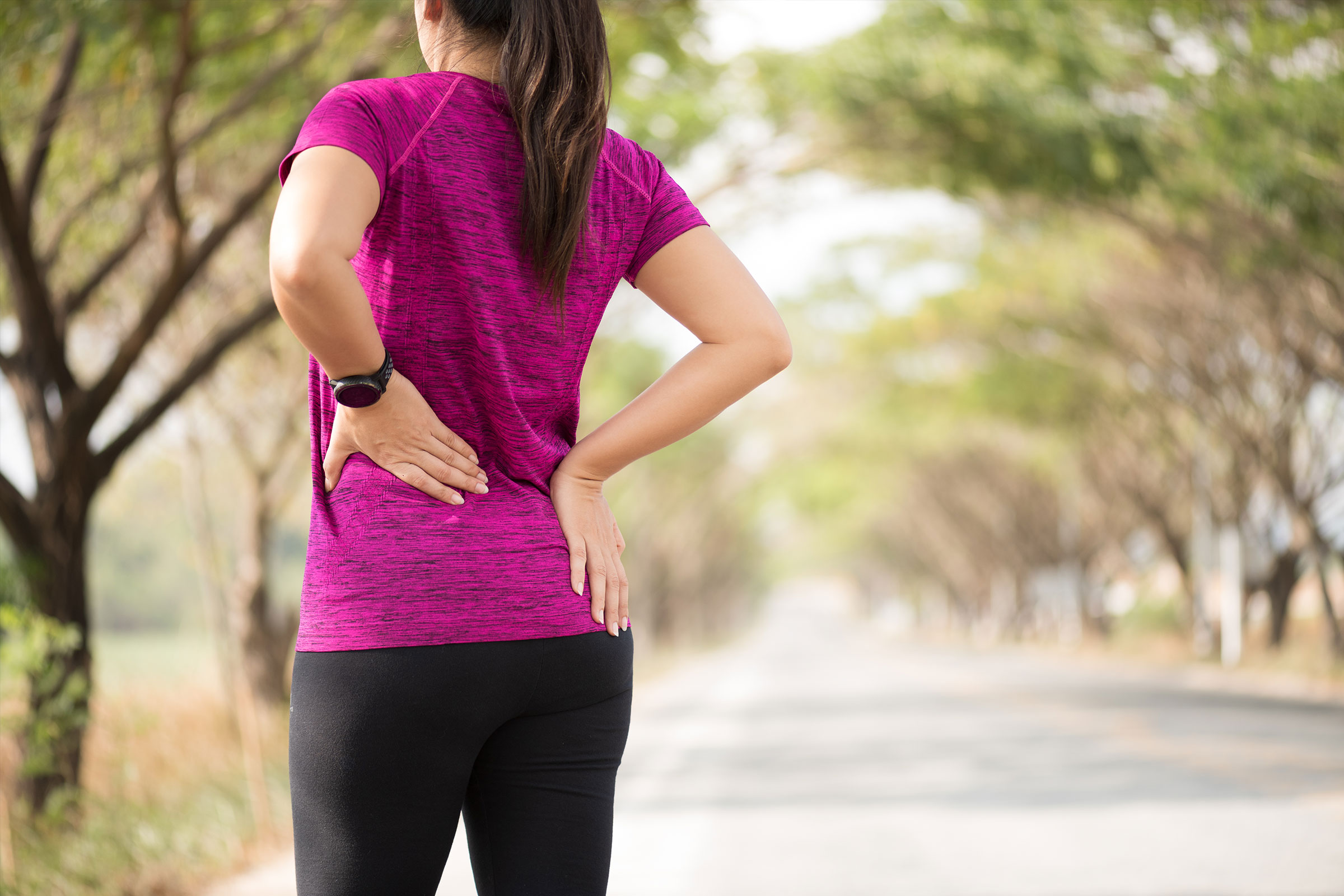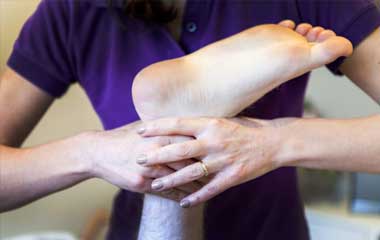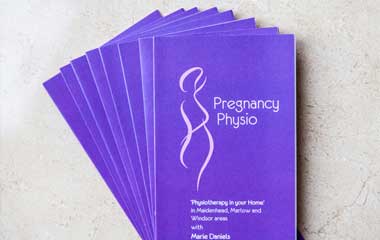
Back Pain
Facet Joint Irritation
Facet joint irritation is an arthritic condition of the spine that can be a significant source of back pain. It is caused by wear and tear to the joints between the bones of the spine resulting in inflammation and triggering pain. Often the pain is localised and typically presents as a dull ache in the lower back. The pain can refer to the buttocks, hips, thighs or knees. Activities that involve twisting (like golf) can aggravate the pain or leaning backwards and over-extending.
Our Physiotherapy treatment for facet joint pain may include:
- Manual therapy, such as joint mobilisations for pain relief or to reduce joint stiffness
- Soft tissue release to relieve tight muscles
- Acupuncture to reduce leg pain
- Pilates exercises to help support and strengthen the back
Disc Prolapse/Disc bulge/Slipped Disc
A disc prolapse occurs when one of the discs becomes inflamed or swollen and bulges, more often at the level of L4/5 and L5/S1. It can happen suddenly as a result of a sudden movement (bending/twisting, lifting) or accident or build up gradually, over time. The pain is normally quite deep and achy. Coughing, sneezing, bending or prolonged static postures generally worsen the pain. If the bulge of the disc causes pressure on the nerve exiting the spine, then there can be associated leg pain, pins and needles and reduced sensation or even motor disturbance with weakness in the legs.
Most people recover over 6 weeks to 3 months with conservative management from a physiotherapist. If symptoms fail to settle and pain persists, there is the option of a steroid epidural injection. Surgery is only indicated as a last resort for progressive neurological problems (increasing numbness, weakness, paralysis of that nerve). The physiotherapist will be able to recommend referral to a spinal specialist.
Our Physiotherapy treatment for disc prolapse may include:
- Manual techniques, such as joint mobilisations for pain relief or to reduce joint stiffness
- Soft tissue release for muscle tightness
- Taping to provide support and stability of joints and muscles
- TENS for pain relief / Ultrasound to reduce inflammation and optimise healing
- Exercises to improve flexibility, core strength and posture which help to reduce the pain and prevent another episode
- 1:1 Pilates training
- Education and advice on light exercise, pain management, lifestyle modification, avoiding aggravating factors (bending, lifting, prolonged sitting/standing) and a return to work plan
Sciatica
This occurs when the sciatic nerve becomes compressed as it exits the spinal vertebrae resulting in intermittent sharp, throbbing or burning pain radiating down the legs. Sometimes this is accompanied by altered sensation such as pins and needles or numbness and motor disturbance with weakness in the legs. The most common cause is a slipped disc in your spine.
Physiotherapy treatment for sciatica aims to alleviate pain, restore mobility and function with:
- Soft tissue release
- Manual therapy, such as joint mobilisations for pain relief or to reduce joint stiffness
- Acupuncture for reducing leg pain
- Pilates to strengthen core and gluteal muscles to help stabilise the spine and prevent a recurrence
Muscle Spasm
Muscle spasm in the back often develops immediately post injury and acts as a protective mechanism. Active trigger points (acutely tender spots) can then develop in muscles in spasm which may refer pain to other areas of the body, local or distal to the spine.
Our Physiotherapy treatment for muscle spasm involves:
- Manual therapy to release trigger points and muscle spasm
- Acupuncture to release muscle tightness and lengthen the muscle
- Exercise advice to strengthen weak muscles and lengthen tight muscles with stretching to prevent the spasm from returning
Degenerative Disc Disease/Osteoarthritis/Spondylosis
Wear and tear is often called osteoarthritis, degenerative disc disease or spondylosis. It all means the same thing and is a normal part of the aging process! It occurs in later life when the discs in the spine become dehydrated and lose their height. This leads to wear and tear (degeneration) of the joints in the spine which can also affect the nerves that exit from the spine. Typically, patients report a dull ache in the lower back which can refer to the buttocks, groin and outside of the hip. Sometimes, there can be numbness and tingling felt in the legs and the muscles in the legs can feel weak.
Our Physiotherapy treatment for Osteoarthritis of the spine may include:
- Manual therapy to reduce the pain and restore normal sensation
- Taping to support the spine
- Acupuncture to reduce aching pain
- Pilates to improve flexibility, posture and strength around the lower back
Postural strain
Good posture involves maintaining three natural curves in your spine – an inward curve in the lower back, an outward curve in the mid back and an inward curve at the neck. Typical examples of people adopting poor postural habits are slouching or sitting slumped on an office chair, sitting on a bed while working on a laptop and bending their backs lifting heavy objects off the floor and they lose their natural curves. As a result, the main supporting structures of the spine (muscles, discs and joints) become overloaded, causing pain.
Physiotherapy can help with:
- Soft tissue release or massage to relieve muscles that have become overactive and tight
- Manual therapy, such as joint mobilisations for pain relief or to reduce joint stiffness
- Acupuncture for pain relief
- Pilates to improve flexibility, posture and strength around the lower back
Spondylolisthesis (lower back pain)
This condition refers to the slippage of one vertebra forwards on the vertebra below. It is most commonly seen in children between the ages of 9 and 14, and can develop from doing a repetitive sport eg gymnastics involving extreme upright postures and leaning backwards. Patients complain of low back pain (LBP) with or without leg pain. Bending forwards often improves the pain.
Physiotherapy treatment for spondylolisthesis aims to stabilise the spine with:
- Mobilisations of stiff joints above and below the site of the slippage
- Massage to muscles that have become overused and tight
- Pilates focussing on core and gluteal strengthening exercises
- Acupuncture for pain relief
Sacroiliac Joint Dysfunction (SIJ pain)
Dysfunction in the sacroiliac joint (SIJ) can sometimes cause lower back and/or leg pain. The sacroiliac joint connects the hip bones (iliac crests) to the sacrum, the triangular bone between the lumbar spine and the tailbone (coccyx). The main function of the SIJ is to absorb shock between the upper body and the pelvis and legs. The joint is reinforced by strong ligaments and muscles surrounding it. Hypermobility (too much movement) in the SIJ can cause the pelvis to feel unstable and lead to pain. This is typically felt in the lower back and/or hip and may radiate into the groin area. Hypomobility (too little movement or fixation) can cause muscle tension and pain which is typically felt on one side of the low back or buttocks and can radiate down the back of the leg (similar to sciatica). Sacroiliac joint dysfunction is more common in women who are pregnant (pelvic girdle pain) or have just given birth. More information can be found on the pregnancy information.
Our Physiotherapy treatment for sacroiliac joint dysfunction may include:
- Muscle energy techniques to restore any pelvic malalignment that tends to occur in pregnant women
- Joint mobilisations for pain relief or to reduce joint stiffness
- Acupuncture for pain relief
- Pilates exercises for posture improvement and strengthening to the lower back
Chronic Pain
Acute pain is the pain we feel immediately after injuring ourselves and while the injury is undergoing repair ie: touching a hot object. Chronic pain is pain that continues even though healing has occurred and the link between pain and damage is complicated. It is not unusual to find no direct link between the original damage (which may have long healed) and ongoing pain. Chemical changes happen in the brain and spinal cord to re-route signals to pain centres in the brain. Normal sensation such as movement, touch, pressure, stretch, hot and cold can therefore all be felt as pain. Sometimes the pain system can be activated without even any physical stimulus by changes in the weather, by mood and thoughts or even no stimulus at all.
Physiotherapy for chronic pain has to consider multiple aspects and address other factors that are involved rather than just focussing on the pain itself. In addition to treating the pain, physiotherapy employs self- management strategies including advice on pacing and mechanisms to cope with flare ups and negative thoughts, graduated exercise programmes and goal setting. Our aim is for you to return to work, sport or hobbies that you were involved in before developing chronic pain. If necessary, a physiotherapist will be able to recommend pain consultants to help manage your pain.








